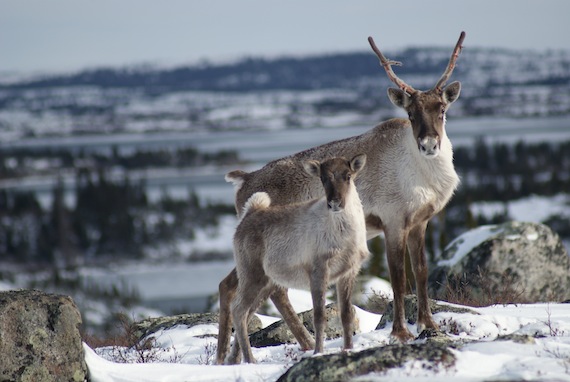Inuit organizations raise caribou concerns at mine expansion hearing
Baffinland said sloped embankments and underpasses along a proposed rail route should minimize impacts.

When was the last time caribou were seen on the road between Baffinland Iron Mines Corp.’s Mary River mine and its port at Milne Inlet?
Paul Irngaut, Nunavut Tunngavik Inc.’s director of wildlife and environment, raised this question at the Nunavut Impact Review Board’s hearing on Baffinland’s expansion plans in Iqaluit on Tuesday, Nov. 5.
It was 2013, said Baffinland consultant Mike Setterington. That was before the mine was in operation.
But that doesn’t mean the mine road scared the caribou away, he said.
“North Baffin caribou follow population cycles,” Setterington said. The population peaked in the 1930s, declined in the 1940s and peaked again in the late 1990s and early 2000s. (He noted some data is missing for intervening years.)
“The population started declining in the late 1990s, before exploration began,” Setterington said.
The population has yet to recover and the latest counts put caribou of north Baffin anywhere between 152 and 600.
Baffinland has said impacts of the second phase of development on caribou of the area will be negligible. That includes the construction of a 100-kilometer rail line and increasing haul traffic on the tote road until that rail is complete.
This would allow Baffinland to increase production from 6 million tonnes of ore per year to 12 million tonnes.
Baffinland has been fielding criticism for its approach to engaging local communities. And intervenors on the project disagree with the assessment of negligible impacts.
“Caribou are very sensitive. They’ll stop at a snowmobile track, so it’s not surprising there’s no evidence of caribou crossing the tote road,” said Irngaut. “If you build a railroad, that’s two barriers for them to cross.”
Lou Kamermans, director of sustainable development with Baffinland, pointed out that the tote road was first built in the 1960s and has since been used by caribou. “We’re fairly confident caribou have shown they will cross linear infrastructure,” Kamermans said.
Due to the low population of north Baffin caribou, Baffinland’s impact estimates have been based around caribou interactions with other northern extraction projects, diamond mines in particular.
Susan Leech, an environmental consultant with the Qikiqtani Inuit Association, pointed out that no additional impacts were assessed for the interim period of increased trucking on the tote road.
She questioned Baffinland’s claim that 66 percent of their proposed railway will be passable for caribou. She asked whether its accounting of this included sensory disruptions like smell and sound.
Setterington said the company included these considerations, but, having no data from north Baffin to base it on, they relied on information from northern diamond mines.
Given that, David Lee, with NTI, asked about the validity of this study and why confidence levels weren’t offered. Those would give a measure of the precision of the data used.
Setterington responded that it was not a scientific study, but theoretical, to try to estimate the sensory effects on animals due to habitat loss.
He said they had moderate levels of confidence in their impact prediction, but that ongoing monitoring remains important. So is the future study of caribou in the area, when their population rebounds.
“I am concerned about the emphasis put on these studies,” Lee responded.
Kamermans said Baffinland feels the evidence it has provided is valid. But he added that they are still open to altering the planned infrastructure and operations to accommodate caribou.
Right now, the railroad is planned to sit atop sloped embankments designed to be crossable for caribou. Inuit have noted that caribou are able to climb mountain slopes, said Setterington. The company was also informed by the road designs at other northern mines.
The rail plan also includes culverts to allow caribou to pass beneath the railroad, and level crossings that would be shared by people and caribou.
Charlie Inuarak, a former mayor of Pond Inlet, cast doubts on these measures.
“Caribou will not want to use a crossing where there are tracks from transportation or any human activity,” he said. “The female caribou is very sensitive to smells … they can tell every time there’s human activity, just when they’re near any tracks.”
He said the underpasses for caribou would be the better option. He also said various points for crossing, which Baffinland has outlined, would be important as caribou move to different areas in changing weather.
“Ask hunting experts. They’re very familiar with the biology of the caribou: what bothers them and how they migrate through that area,” Inuarak said.
Baffinland has held workshops on caribou crossings and hosted a site visit to Mary River where mock-ups of the railway embankments were built.
From this trip, Amanda Hanson Main, with the Mittimatalik Hunters and Trappers Organization, asked whether Inuit indicated that the embankments would pose a barrier to caribou.
Megan Lord-Hoyle, Baffinland’s vice-president of sustainable development, responded,“I did hear from participants that caribou would be able to cross the embankments.”
“That suggests physical ability,” Hanson Main said.
But the lingering question remained: would they?
The Nunavut Impact Review Board brought its final hearing on Baffinland’s proposed expansion of the Mary River mine to an abrupt halt on Nov. 6, the fifth day of the hearing. That’s because the board needs time to consider a motion from Aluki Kotierk, the president of Nunavut Tunngavik Inc., to adjourn the hearing for eight to 12 months.